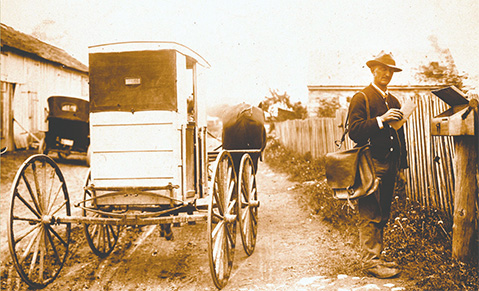by James Rada, Jr.
Rural Free Delivery
in Northern Frederick County
Better late than never, as they say.
The United States Post Office started experimenting with Rural Free Delivery in 1891. Despite starting in neighboring Carroll County, the home delivery of mail didn’t reach Frederick County until 1901.
However, it wasn’t as if the county was clamoring for it. The Catoctin Clarion reported in 1900, “The rural free delivery grows more unpopular every day, with our citizens. There are constantly being new disadvantages and inconveniences discovered which will never be made satisfactory under our present system.”
In February 1901, it looked like the system would be instituted in Frederick County in early 1902. The system employed mail wagons and carriers on foot to deliver mail to the homes of residents.
The Clarion reported, “Regarding the proposed extension of the system over the whole of Frederick County. Representative Pearre says, in a letter to The News: ‘It will put into Frederick county about $20,000 a year in the shape of salaries to letter carriers. In a nut shell, the system furnishes to the man in the rural district the same conveniences that the carrier system furnishes to a man in the city. I have absolutely no interest in the introduction of the rural free delivery system, except to give added conveniences and facilities to the people. Convinced as I am that the government is ready to furnish this great convenience to the farmer, I am going to try to introduce it.’”
As the year progressed, so did support for rural free delivery (RFD). In July, a group of Thurmont-area businessmen organized the Sweigart Manufacturing Company of Frederick County. Webster W. Sweigart had developed and patented a mailbox that the government approved for use on RFD routes.
An early problem with RFD was that people set out all sorts of boxes for their mail. The postal service issued a rule that all mailboxes had to be one of 14 approved designs. If a resident didn’t have an approved mailbox within 30 days of the start of the service, they wouldn’t receive mail.
The following month, orders were placed for blue mail wagons that would have yellow running gear and white canvas tops.
RFD came to Frederick County two months earlier than expected, starting on November 15, 1901. The new mail carriers were civil servants. “Appointments of them will be made from persons residents of the neighborhood, wholly for fitness and irrespective of political or personal considerations,” according to the Catoctin Clarion.
Thurmont had one mail wagon and three mail carriers. An additional mail carrier for Lewistown worked with the Thurmont carriers. C. C. Currens drove the mail wagon, and Morris Rouzer served as the Thurmont mail clerk. William H. Damuth, Frank Albaugh, J. H. Freeze, and W. P. Mohler (for Lewistown) were the mail carriers. The wagon’s route took nine hours, running from 7:00 a.m. to 4:00 p.m. The carriers walked their routes from 7:00 a.m. to 12:30 p.m.
Emmitsburg had four mail carriers: James G. Bishop, Charles R. Lander, A. E. Weaver, and Vernon Lantz. Charles Gillelan served as a substitute carrier. The average route for the Emmitsburg carriers were 21 miles.
Some of the new regulations that the mail carriers had to get used to were, according to Carl V. Besore and Robert L. Ringer in A Reflection of the History of Waynesboro, Pennsylvania and Vicinity:
• The mail carriers had to keep a count of all mail picked up on the route each day.
• Any mail the carrier collected that could be delivered before returning to the post office, first had to have the carrier cancel the postage with an indelible pencil.
• The carrier had to keep postage stamps, cards, stamped envelopes, and money order blanks with him. “If patrons entrusted him, the carrier could act as their agent, enclosing their money in the stamped addressed envelope given him by the patron,” Besore and Ringer wrote.
• If carriers met one of the people on their route while they were driving, they could deliver their mail to them if requested, but only if it cost them no time on their route.
• Carriers had to deliver registered mail and pension to the addressee’s home as long as their mailbox was less than a mile off the route. If the house was further away, a note would be left in the mailbox, explaining who could get the mail and where it could be obtained.
• Special delivery letters would be delivered to the addressee’s house if it was within a mile of the mailbox. If the house was further away, the letter would be left in the mailbox as ordinary mail.

A mailman servicing an RFD in Pennsylvania.

